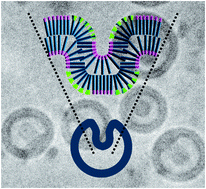To elucidate the molecular basis and role of lipid surface domains in cellular processes, giant unilamellar vesicles (GUV, 10–100 μm) have been widely studied as a simple model system. Due to the large average diameter of these giant liposomes, the phase separation of different lipid mixtures – usually as a result of mismatch between the phospholipid chains – can be readily investigated with optical microscopy. With GUVs it was shown that raft formation in some cases leads to local membrane curvature at the domain boundaries or to complete shape deformation. Lipid raft formation is a great source of inspiration for the creation of complex artificial systems like polymer-based vesicles. Polymeric vesicles, known as polymersomes, are the more robust analogues of liposomes; they are composed of high molecular weight amphiphilic block copolymers instead of low molecular weight phospholipids and therefore consist of a membrane exhibiting superior physical and chemical stability. Despite this toughness, polymersomes are capable of domain formation when two or more distinct block copolymers are blended within one membrane. However, the number of studies reporting domain formation in nanoscaled polymersomes is limited because the characterization of polymer/polymer segregation in nanoscale vesicular structures remains a challenge to date.

In this study, van Hest and co-workers demonstrated that nanometer-sized polymersomes assembled from two dissimilar diblock copolymers can undergo shape changes, driven by strong lateral polymer/polymer segregation within the membrane. The two particular block copolymers consisted of identical hydrophobic fragments to stimulate co-assembly, while their hydrophilic segments were either neutrally or negatively charged. It was hypothesized that demixing of the two types of polymer amphiphiles within the bilayer was caused by the different hydrophilic polymer fractions exhibiting intrinsically different interfacial curvatures upon self-assembly. Given the potentially unlimited number of possible hybrid polymersome systems, the local polymer/polymer separation phenomenon could be easily exploited further in the construction of new polymersome morphologies, with potential applications in both nanoscience and biomedical fields.
Spontaneous shape changes in polymersomes via polymer/polymer segregation by Silvie A. Meeuwissen, Stéphanie M. C. Bruekers, Yingchao Chen, Darrin J. Pochan and Jan C. M. van Hest Polym. Chem. 2014, 5, 489-501.
Julien Nicolas is a web-writer and advisory board member for Polymer Chemistry. He currently works at Univ. Paris-Sud (FR) as a CNRS researcher.











